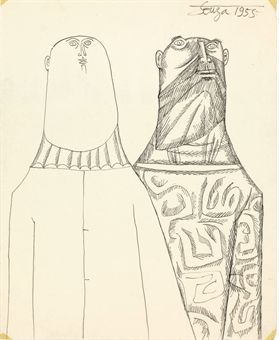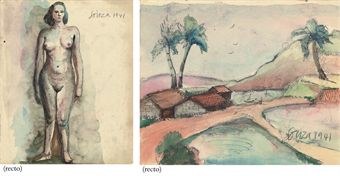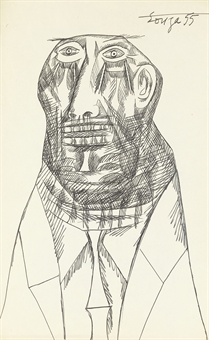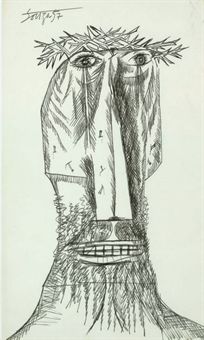FRANCIS NEWTON
SOUZA

F N Souza is regarded as one of the most prolific modern artists to come out of the artistic renaissance in India that coincided with the country’s independence. Souza was born in the 1920s in an orthodox Christian family in rural Goa on the southern
 coast of India. He was initially supposed to be ordained as a priest however he was expelled from the convent where attended school after being accused of drawing pornographic images on the walls of the bathroom. He later wrote of the incident saying that he was merely correcting the bad job done by the actual per perpetrator. He later attended the Sir J.J. School of Art in Bombay but was suspended in 1945 for participating in nationalistmovements against the British government of the time. He later went on to found the Progressive Artists Group with fellow artists like M.F Hussein and S.H. Raza who would go on to become stalwarts of Indian
coast of India. He was initially supposed to be ordained as a priest however he was expelled from the convent where attended school after being accused of drawing pornographic images on the walls of the bathroom. He later wrote of the incident saying that he was merely correcting the bad job done by the actual per perpetrator. He later attended the Sir J.J. School of Art in Bombay but was suspended in 1945 for participating in nationalistmovements against the British government of the time. He later went on to found the Progressive Artists Group with fellow artists like M.F Hussein and S.H. Raza who would go on to become stalwarts of Indian Modern Art. Though he received little appreciation during his lifetime, which was marred with episodes of bankruptcy, alcoholism, destitution and conniving gallery owners, soon after his demise in 2002 his work shot into lime light and soon occupied center stage in art auctions and exhibitions alike.He is one of the few artists who considered drawing to be an important medium of expression in itself. Because Souza had a knack of drawing from a very early age (he painted the work on the right at age 17), his body of work on paper is an extensive one. So much so that his drawings are often used to map his progress from a young energetic teenager during his formative years to the master of line that he later matured into.
Modern Art. Though he received little appreciation during his lifetime, which was marred with episodes of bankruptcy, alcoholism, destitution and conniving gallery owners, soon after his demise in 2002 his work shot into lime light and soon occupied center stage in art auctions and exhibitions alike.He is one of the few artists who considered drawing to be an important medium of expression in itself. Because Souza had a knack of drawing from a very early age (he painted the work on the right at age 17), his body of work on paper is an extensive one. So much so that his drawings are often used to map his progress from a young energetic teenager during his formative years to the master of line that he later matured into.What governed Souza’s drawing style was not how the eye perceived the surroundings but what the image felt like. For example, his numerous cityscapes and representations of mythical scenarios aren’t really representational of specific physical or geographical locations but are
 rather like the masterpiece of a 4 year old or like the robots and monsters that children draw to get through a boring class in school. They have the same perplexing quality, wherein the first impression is that the drawing is definitely representationally inaccurate but as we give it a second look we realize the different dimensions that are encapsulated in the work.
rather like the masterpiece of a 4 year old or like the robots and monsters that children draw to get through a boring class in school. They have the same perplexing quality, wherein the first impression is that the drawing is definitely representationally inaccurate but as we give it a second look we realize the different dimensions that are encapsulated in the work.His drawings are often of a mathematical nature, in the sense that you feel that there is a pattern. It is as if he decided to draw something but decided to do so using a particular process. I feel it is similar to the way Picasso drew from observation but he put the image through a cubist “process” or the way Seurat put his images through a pointillist “process”.

His early work can be seen to be influenced by his beautiful surroundings in lush Goa and seem also to derive a lot of imagery from Christian iconography prevalent in the region. He often returned to these themes and later ventures into Hindu iconography. His favorite subject however – one which he would return to throughout his career would have to be – The Human Head. His fascination with the human head was a truly remarkable one. Right from his early portraits to his heavily worked masterpieces from his mature period, Souza’s heads were what dominated his creations.
Other than simple drawing with pen or pencil on paper, Souza developed a unique method of working using magazine paper. He would use acid or other chemicals to dissolve the bright pigments used to print magazines and use them to draw images. These images often seem urgent rushed and forceful as the pigments could only remain fluid for a few minutes at a time - thus he had to be quick with his brush strokes. Even though he developed this technique over 5 decades ago, it remains unique to him.
No comments:
Post a Comment